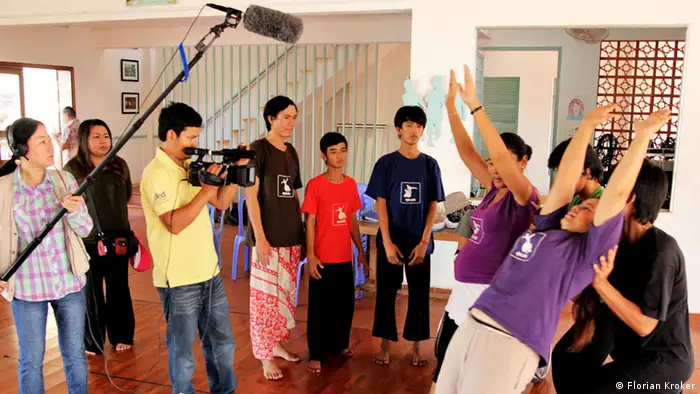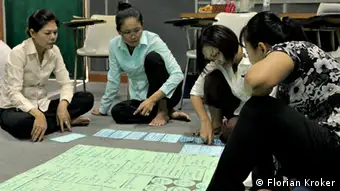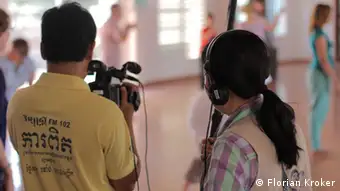Asia
Cambodia: Portraying people with disabilities
In many societies, people with disabilities are pushed aside. And, as in Cambodia, the media rarely portray their lives. A recent TV workshop there focused on bringing people with impairments back into public view.
It's the second day of shooting. Journalist and workshop participant Raksmey An has overcome her initial reservations and simply hands her bulky tripod and camera bag to one of the staff members at the "Epic Arts" center for the disabled. He's helping her transport her equipment to the next location via motorbike. Although he has no arms he"s learned how to compensate by using his head, shoulders and legs."Raksmey had never worked with people with disabilities before," says TV trainer Bettina Ruigies, "and that was one of the goals of the workshop. Now she no distinguishes between people with disabilities and those without."
"Including people with disabilities" was a TV training project jointly organized by DW Akademie, Germany's GIZ and the Women's Media Centre of Cambodia. The project had two goals: to raise awareness about and better integrate people with disabilities into Cambodian society, and to teach documentary filmmaking - a skill rarely used in the country.
The 14 participants were staff from the Women's Media Centre of Cambodia (WMC). In many ways it was a ground-breaking experience for this group of journalists, camera operators and editors. Until then they had used scripts and actors to produce soap operas carrying social messages. Now they were facing the challenge of using a documentary approach.
Just as fascinating as a soap opera
"At first participants thought documentaries were easier to produce than fiction," says trainer Bettina Ruigies. She ran the workshop together with digital media designer, Florian Kroker. But she says after initial hands-on exercises participants discovered that filming with "real" people at "real" locations could be quite exhausting, that portraying real life was harder to plan than filming from a script. "At the end, though, they were surprised that their reports were as exciting as soaps," says Ruigies.
#video#Two intense workshops were held in November and December 2012. They concentrated on the theoretical basics of documentary filmmaking and then gave participants time to produce their first films. The results included sensitive - and for Cambodian television, unusual - portraits: a blind couple who works as masseurs, a blind NGO public relations employee, and a village schoolgirl who had lost an arm and leg. The participants also worked together to produce a documentary about the "Epic Arts" center located in the southern Cambodian city, Kampot.
See ability, not disability
In Cambodia people with mental or physical impairments are pushed aside. Some become street beggars, others are shielded or locked away. The country's Disability Action Council (DAC) estimates that nearly five percent of the population of 14.9 million have disabilities. According to the UN Economic and Social Commission for Asia and the Pacific (UNESCAP), the high rate in Cambodia can be mainly attributed to three factors: past war casualties, the ongoing risk of mines, and the lack of prevention and primary care for various disabling diseases.
"When the workshop began participants mainly felt sorry for people with disabilities," says Ruigies. "But then they saw that with the necessary support they could lead independent lives." Participants were so impressed by sign language that they continued to sign for days after filming had stopped.
There is little coverage of people with disabilities in Cambodia, partly because journalists feel too shy or know too little about the issues. But the recent TV workshops are helping to break down barriers and improve how journalists portray those with disability challenges.
- Date 14.02.2013
- Author Nadine Wojcik / hw
- Print Print this page
- Permalink https://p.dw.com/p/17dtl
- Date 14.02.2013
- Author Nadine Wojcik / hw
- Print Print this page
- Permalink https://p.dw.com/p/17dtl



